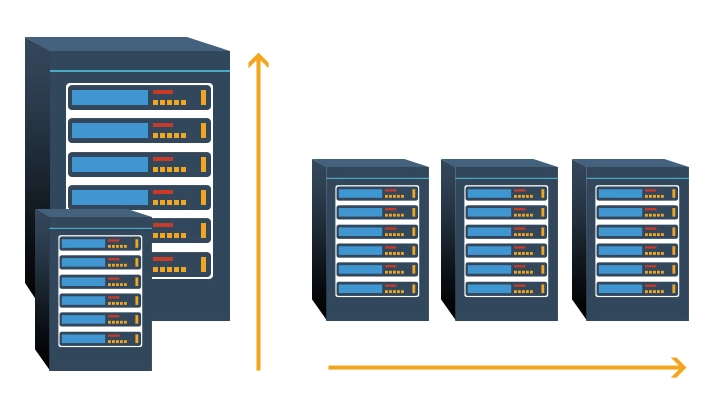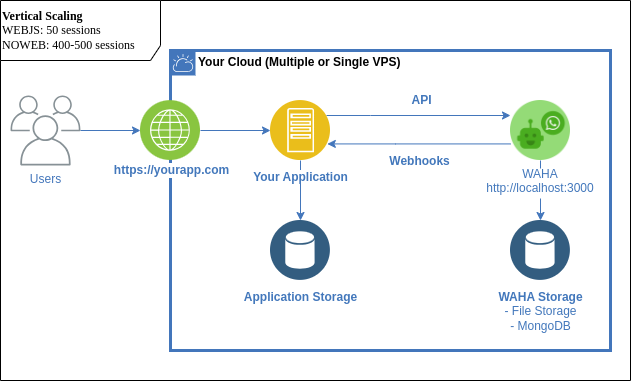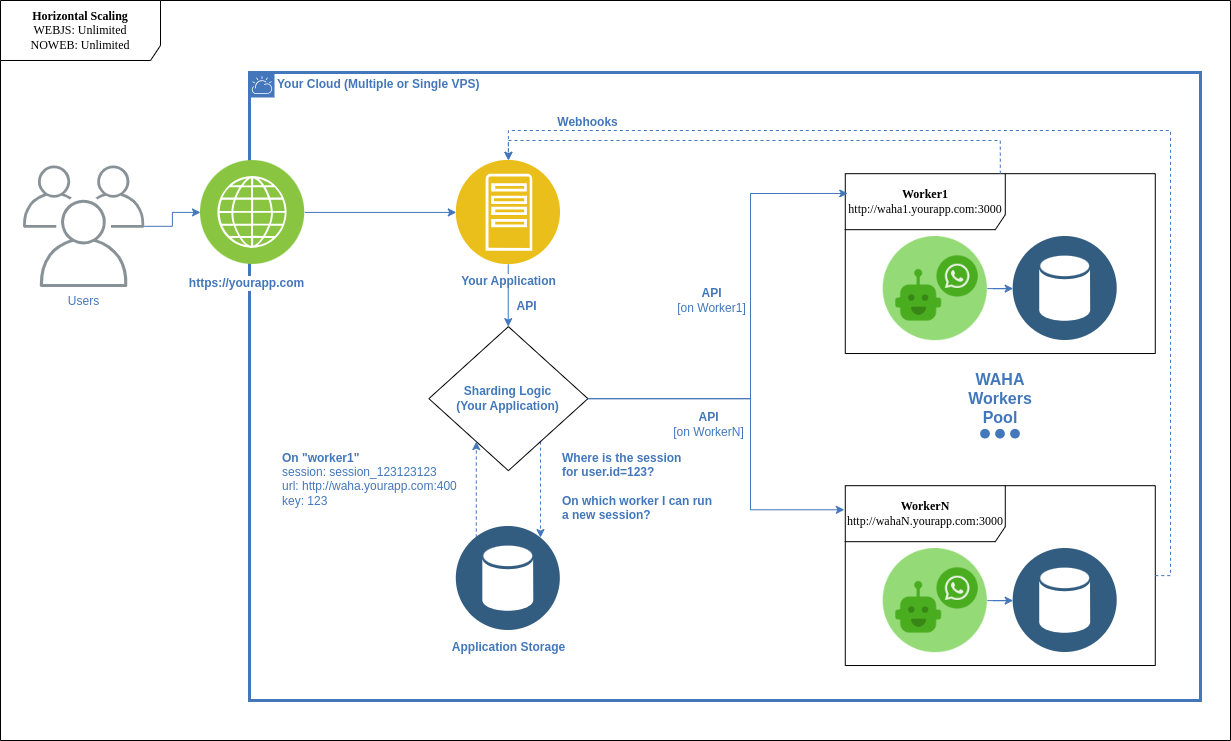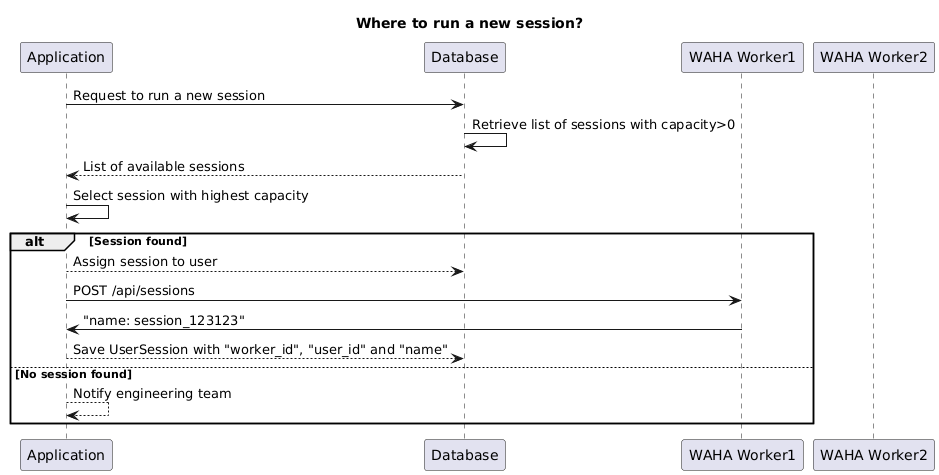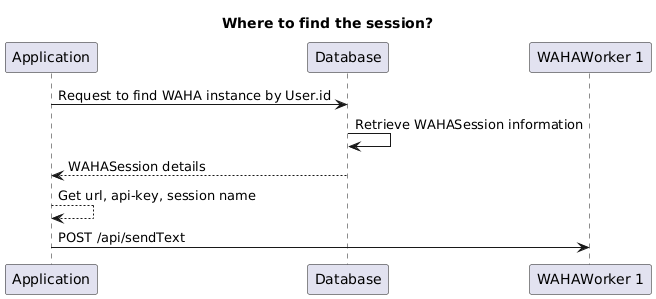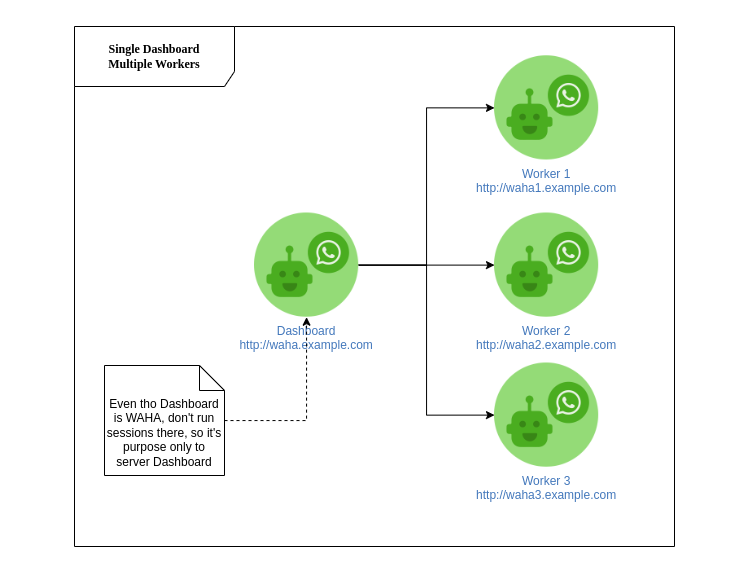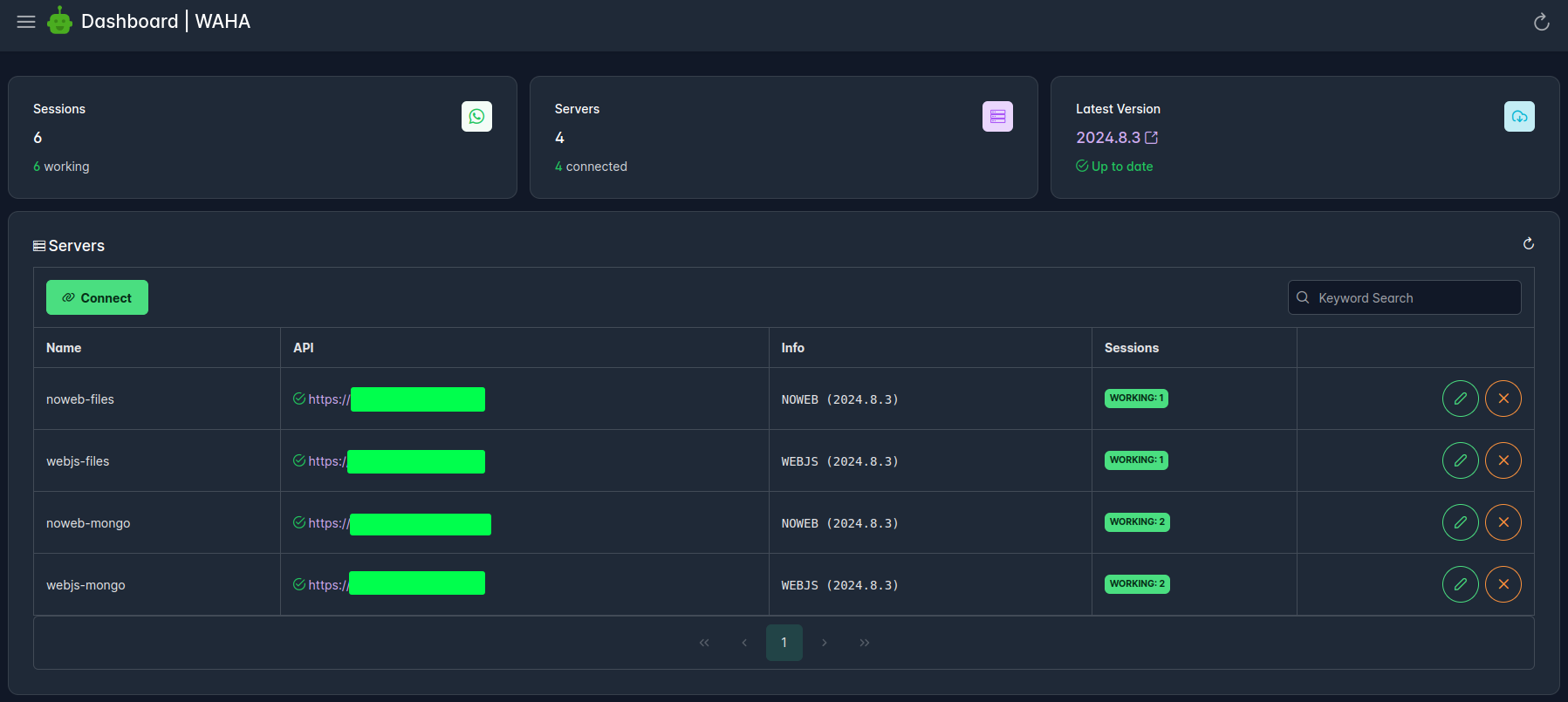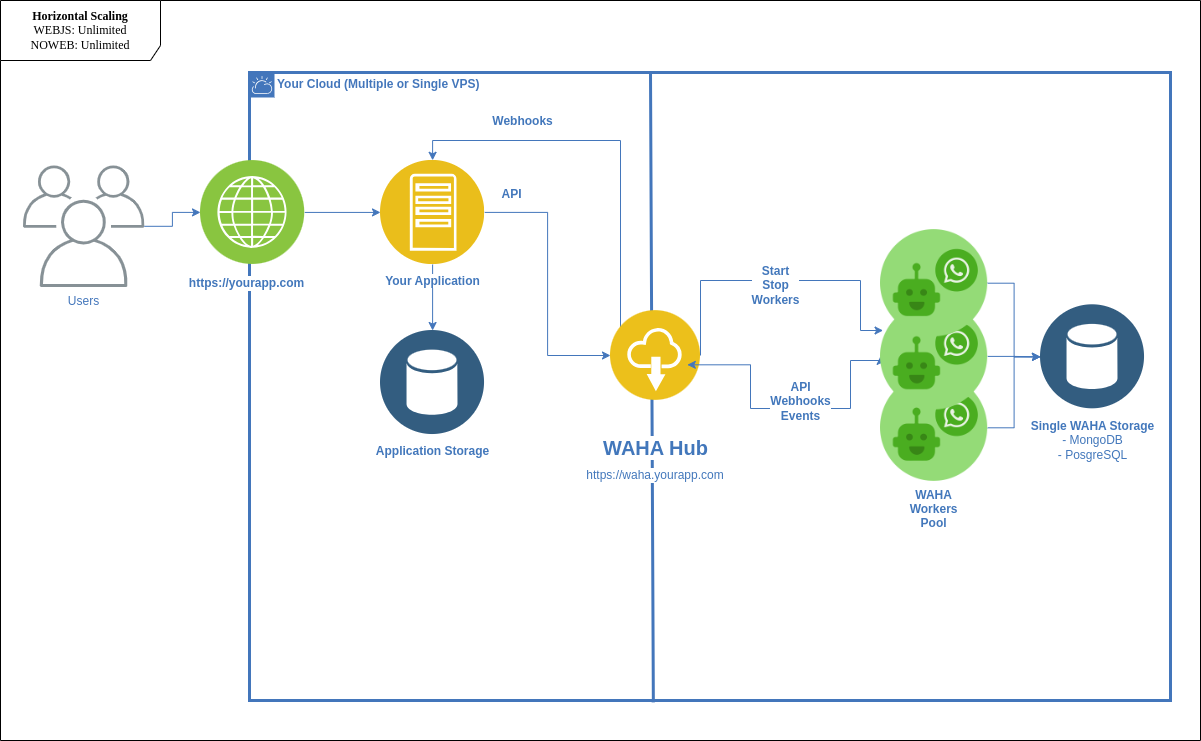WAHA Scaling - How To Handle 500+ Sessions
August 14, 2024 in Tips by devlikeapro6 minutes
Overview
This article is for people who want to scale their WhatsApp API for customers, like CRM, SaaS, or other services and who need to handle a lot (>100) of 🖥️ Sessions (WhatsApp Accounts).
If you’re using WAHA for 1-10 sessions - just make sure to follow the 🔧 Install & Update guide. It handles all the necessary steps to make it work. 🚀
There are two ways to scale WAHA:
- Vertical Scaling - adding more resources (CPU, RAM) to a single server to handle more sessions. That’s a good way to go if you need to handle up to 50 sessions (WEBJS) or 500 sessions (NOWEB).
- Horizontal Scaling - adding more servers to handle more sessions. Requires a bit more work to set up, but it’s the best way to go if you need to handle more than 500 sessions.
Vertical Scaling

Vertical Scaling is the process of adding more resources (CPU, RAM) to a single server to handle more sessions.
Assuming you’ve followed the guide 🔧 Install & Update and you have something like this architecture:
How many sessions can you run by adding more resources (CPU and RAM) to a single WAHA server?
Here’s an approximate example of how many sessions you can run on a single server using the Vertical Scaling approach:
| 🏭 Engine | Sessions | CPU | Memory |
|---|---|---|---|
| WEBJS | 10 | 270% | 2.5GB |
| WEBJS | 50 | 1500% | 20GB |
| NOWEB | 50 | 150% | 4GB |
| NOWEB | 500 | 300% | 30GB |
👉 The benchmark may differ from case to case, depending on usage patterns - how many messages you receive, how many you send, etc.
So if you need to run up to 50 sessions on the WEBJS engine or up to 500 sessions on NOWEB - you can just keep adding more resources (CPU and RAM) to the single server! Fast to scale, easy to manage. 🎉
If you want to run more sessions - you need to consider Horizontal Scaling. It’s not safe to run more than the above numbers on a single server!
Horizontal Scaling - Sharding

Horizontal Scaling is the process of adding more servers to handle more sessions.
Right now, the only way to do it is to run multiple WAHA instances and distribute the sessions between them in Your Application logic using the Sharding technique:
Here are the key points for setting up Horizontal Scaling using the Sharding technique:
- You run multiple WAHA instances listening on different hostnames
(
http://waha1.example.com,http://waha2.example.com, etc.) or ports (http://waha.example.com:3001,http://waha.example.com:3002, etc.). - You save the list of
url,api-key,capacityto Your Application Database - Entities Schema - When a new user asks to run a new session - you follow the Where to run a new session?
logic to find a suitable WAHA instance and save the
user <-> session <-> serverassociation to Your Application Database. - When you need to send a request to WhatsApp API - you follow the Where to find the session? logic to find the WAHA instance to send the request.
- All webhooks come to Your Application directly from the WAHA instance, so you don’t need to worry about it.
We’ll guide you through the process of setting up Horizontal Scaling using the Sharding technique in the next sections.
👉 Please note that each WAHA Worker must have its own database or WAHA_WORKER_ID=waha{N} environment variable set
for either File Storage or MongoDB URL (not a database).
Entities Schema
In order to save WAHA instances and session associations, you
need to have the following entities in Your Application Database:
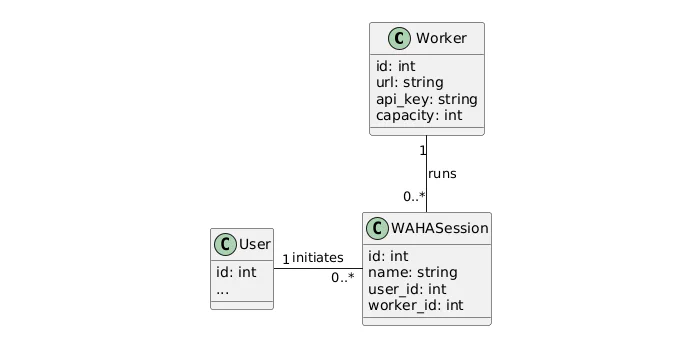
Worker
Worker represents a single WAHA instance that can handle sessions.
id- unique identifierurl- URL of the WAHA instance,http://waha1.example.com,http://waha2.example.com, etc.api_key- API Key to authorize requestscapacity- how many sessions can be run on the WAHA instance (for simplicity, we’re using a single field, but it can be a new model AvailableSession or similar).
By setting capacity, you can manage the WAHA Worker usage and prevent overloading.
User
User is a user of Your Application that can run sessions.
id- unique identifier
👉 You can use either User or Tenant or Organization - it completely depends on your application logic and business model. We’ll use User for simplicity with a single field:
WAHASession
WAHASession represents a single session that is running on the WAHA Worker associated with the User.
id- unique identifiername- WAHA sessionnameuser_id- reference to the Userworker_id- reference to the Worker
Where to run a new session?
When a new user asks to run a new session - you need to find a suitable WAHA instance to run it.
You can simply get a list of sessions with capacity>0 and pick the one with the highest capacity.
This is just an example with simple logic. You can adjust it and distribute WhatsApp sessions based on country, proxy settings, customer level, etc.
Where to find the session?
When you need to send a request to WhatsApp API - you need to find the WAHA instance to send the request.
You can simply get the worker_id from the WAHASession and send the request to the WAHA instance using
the url and api_key.
Why this way?
WAHA is not a stateless application, it has a runtime state (not technically a state as in database, but still a state) - the connection to WhatsApp (either browser or websocket connection) which cannot be moved automatically, so all HTTP requests MUST be “sticky”, meaning they MUST go only to the certain “worker” - one with a “running” session.
This is why we cannot simply run more containers using Kubernetes Deployment/AWS ECS (though you can use StatefulSets for k8s). We need to care about WHERE we run the session and WHERE we send the request.
And a few more reasons:
- Simple - you don’t need to worry about the load balancer, k8s, docker, etc.
- Independent - you can run WAHA instances on different servers, different cloud providers, bare-metal, etc.
- No single point of failure - if one WAHA instance goes down - the others are still working.
- Flexible - you can configure HOW you distribute sessions across different servers based on your business logic.
- Frees our hands - we can focus on building the best WhatsApp API and adding new features, and you can focus on building the best application. 😊
Single Dashboard - Multiple Servers
If you’re running multiple servers, you can run a dedicated WAHA 📊 Dashboard just to have a single place from which you can manage all servers:
After that, you can connect all servers to the single dashboard:
Horizontal Scaling - Auto-Scaling
🚧🔨⏳ Auto-Scaling IS NOT AVAILABLE out-of-the-box in WAHA yet! ⏳🔨🚧
We’re working on it, but it’s not ready yet, so we’re just giving you a future vision of how it will work.
The idea is to build WAHA Hub that will handle all API requests and distribute them to the WAHA Workers based on information about where each session is running.
It’ll also control (using underlying k8s or docker infrastructure) the number of workers based on the load.
Kindly support the project on the PRO tier if you wish to use this feature in the future! 🙏
For now, Vertical Scaling and Horizontal Scaling - Sharding are the ways to go.
